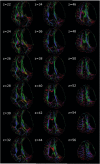Case report: a giant arachnoid cyst masking Alzheimer's disease
- PMID: 31488095
- PMCID: PMC6728996
- DOI: 10.1186/s12888-019-2247-8
Case report: a giant arachnoid cyst masking Alzheimer's disease
Abstract
Background: Intracranial arachnoid cysts are usually benign congenital findings of neuroimaging modalities, sometimes however, leading to focal neurological and psychiatric comorbidities. Whether primarily clinically silent cysts may become causally involved in cognitive decline in old age is neither well examined nor understood.
Case presentation: A 66-year old caucasian man presenting with a giant left-hemispheric frontotemporal cyst without progression of size, presented with slowly progressive cognitive decline. Neuropsychological assessment revealed an amnestic mild cognitive impairment (MCI) without further neurological or psychiatric symptoms. The patient showed mild medio-temporal lobe atrophy on structural MRI. Diffusion tensor and functional magnetic resonance imaging depicted a rather sustained function of the strongly suppressed left hemisphere. Amyloid-PET imaging was positive for increased amyloid burden and he was homozygous for the APOEε3-gene. A diagnosis of MCI due to Alzheimer's disease was given and a co-morbidity with a silent arachnoid cyst was assumed. To investigate, if a potentially reduced CSF flow due to the giant arachnoid cyst contributed to the early manifestation of AD, we reviewed 15 case series of subjects with frontotemporal arachnoid cysts and cognitive decline. However, no increased manifestation of neurodegenerative disorders was reported.
Conclusions: With this case report, we illustrate the necessity of a systematic work-up for neurodegenerative disorders in patients with arachnoid cysts and emerging cognitive decline. We finally propose a modus operandi for the stratification and management of patients with arachnoid cysts potentially susceptive for cognitive dysfunction.
Keywords: Alzheimer’s disease; Arachnoid cysts; Cognitive decline; Functional neuro-imaging; Neural plasticity.
Conflict of interest statement
The authors have no patents pending or financial conflicts to disclose. This research did not receive any specific grant from funding agencies in the public, commercial, or not-for-profit sectors.
Figures




Similar articles
-
A Case of Arachnoid Cyst Presenting with Cognitive Impairment and Hypomania Symptoms.Turk Psikiyatri Derg. 2020 Summer;31(2):131-136. doi: 10.5080/u23937. Turk Psikiyatri Derg. 2020. PMID: 32594501 English, Turkish.
-
Prediction of Alzheimer's Disease in Amnestic Mild Cognitive Impairment Subtypes: Stratification Based on Imaging Biomarkers.J Alzheimers Dis. 2016 Apr 12;52(4):1385-401. doi: 10.3233/JAD-160145. J Alzheimers Dis. 2016. PMID: 27079727
-
Comparison of imaging biomarkers for Alzheimer's disease: amyloid imaging with [18F]florbetapir positron emission tomography and magnetic resonance imaging voxel-based analysis for entorhinal cortex atrophy.Int J Geriatr Psychiatry. 2015 May;30(5):505-13. doi: 10.1002/gps.4173. Epub 2014 Jul 7. Int J Geriatr Psychiatry. 2015. PMID: 25043833
-
Intracranial arachnoid cysts--do they impair mental functions?J Neurol. 2008 Aug;255(8):1113-20. doi: 10.1007/s00415-008-0011-y. Epub 2008 Jul 28. J Neurol. 2008. PMID: 18677648 Review.
-
COGNITIVE AND PSYCHOTIC SYMPTOMS IN A PATIENT WITH INFRATENTORIAL ARACHNOID CYST: CASE REPORT.Acta Clin Croat. 2021 Jun;60(2):304-308. doi: 10.20471/acc.2021.60.02.18. Acta Clin Croat. 2021. PMID: 34744282 Free PMC article. Review.
Cited by
-
Seizures and Postictal Psychosis in a Patient With Retrocerebellar Arachnoid Cyst: A Case Report.Cureus. 2022 May 12;14(5):e24935. doi: 10.7759/cureus.24935. eCollection 2022 May. Cureus. 2022. PMID: 35698697 Free PMC article.
-
Arachnoid cyst presenting as a neurosurgical emergency: a case report.Ann Med Surg (Lond). 2023 Nov 1;85(12):6164-6167. doi: 10.1097/MS9.0000000000001373. eCollection 2023 Dec. Ann Med Surg (Lond). 2023. PMID: 38098583 Free PMC article.
-
The efficacy of cystoperitoneal shunting for the surgical management of intracranial arachnoid cysts in the elderly: A systematic review of the literature.Surg Neurol Int. 2021 Dec 20;12:624. doi: 10.25259/SNI_463_2021. eCollection 2021. Surg Neurol Int. 2021. PMID: 34992940 Free PMC article. Review.
-
Cut it out or wait it out? Case series of middle fossa arachnoid cysts presenting with psychiatric symptoms and a discussion of the ethics of neurosurgical management.Gen Psychiatr. 2021 Dec 17;34(6):e100523. doi: 10.1136/gpsych-2021-100523. eCollection 2021. Gen Psychiatr. 2021. PMID: 34970637 Free PMC article.
-
Giant intracranial arachnoid cyst in an outstanding soldier.Childs Nerv Syst. 2024 Dec;40(12):4361-4364. doi: 10.1007/s00381-024-06616-0. Epub 2024 Sep 13. Childs Nerv Syst. 2024. PMID: 39266703
References
Publication types
MeSH terms
LinkOut - more resources
Full Text Sources
Medical

